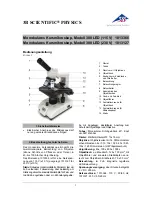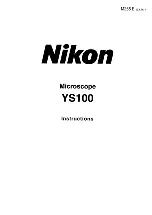
14
the frontal objective lens (normally 100X-Oil). It is important for those objectives that work at a very close
distance to the sample.
For optical components such as eyepieces, condensers, filters
, etc. we recommend using the same
cleaning method. First cleaning it with pressurized dry air, then cleaning it with a cotton swab or a cleaning
cloth for lenses (slightly moistened with a low graduation of alcohol) and finally drying it with pressurized dry air.
Once the cleaning process is finalized if the image is still not clear, you can either contact us or you can contact
your National Optical supplier.
For users that have a digital camera mounted on the microscope
and whom observe dirt on the digital
image, it is important that the first step is to proceed with objectives maintenance, as explained above. If the
dirt persist, it must be determined if it is within the microscope or the camera. To check this simply loosen the
adapter and rotate the camera. If the dirt rotates while turning it, then it means that it is in the microscope. If it
does not rotate, then it is either in the adapter or in the protection filter of the sensor. If the dirt is on the surface
lens of the adapter then you can use the same cleaning method that we have explained above, but if the dirt is
in the protection filter of the sensor then use pressurized dry air only. If the dirt persist you can either contact us
or you can contact your National Optical supplier.
Mechanics
The mechanical components of the microscope require less maintenance than the optical components. Our
first maintenance advice is to
use the dust cover
provided with the microscope, to avoid the accumulation of
dust on the microscope.
To clean the stand or the specimen holder
, Use a cleaning cloth moistened with soap diluted in distilled
water. After this proceed drying the entire surface of the microscope. Take special care with the electrical
components of the microscope such as the ON / OFF switch, the dimmer, the lamp holder…
If there are grease stains, use the same cloth moistened with a low graduation of alcohol.
If you face any problems related to the maintenance of your microscope, please contact us. Our technicians
will gladly help you solve your maintenance issue/s.
CLEANING
– The front lens of the objectives (particularly the 100XRD) should be cleaned after use. The lens
surface may be gently cleaned with a soft camel hair brush, or blown off with clean, oil-free air to remove dust
particles. Then wipe gently with a soft lens tissue, moistened with optical cleaner (eyeglass or camera lens) or
clean water. Immediately dry with a clean lens paper.
CAUTION
- Objectives should never be disassembled by the user. If repairs or internal cleaning should be
necessary, this should only be done by qualified, authorized microscope technician. The eyepiece(s) may be
cleaned in the same manner as the objectives, except in most cases optical cleaner will not be required. In
most instances breathing on the eyepiece to moisten the lens and wiping dry with a clean lens tissue is
sufficient to clean the surface. Lenses should never be wiped while dry as this will scratch or otherwise mar the
surface of the glass.
The finish of the microscope is hard epoxy and is resistant to acids and reagents. Clean this surface with a
damp cloth and mild detergent.
Periodically, the microscope should be disassembled, cleaned and lubricated. This should only be done by a
qualified, authorized microscope technician.
DUST COVER AND STORAGE
– All microscopes should be protected from dust by a dust cover when in
storage or not in use. A dust cover is the most cost-effective microscope insurance you can buy. Ensure that
the storage space is tall enough to allow the microscope to be placed into the cabinet or onto a shelf without
making undue contact with the eyepieces. Never store microscopes in cabinets containing chemicals which
may corrode your microscope. Also, be sure that the objectives are placed in the lowest possible position and
the rotating head is turned inward and not protruding from the base. Microscopes with mechanical stages
should be adjusted toward the center of the stage to prevent the moveable arms of the mechanical stage from
being damaged during storage in the cabinet.
TROUBLESHOOTING

































